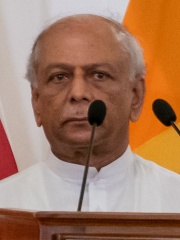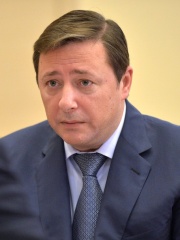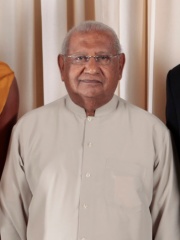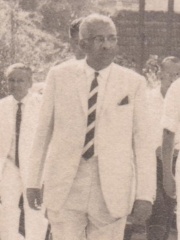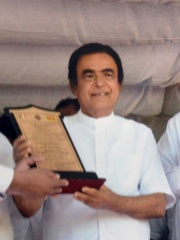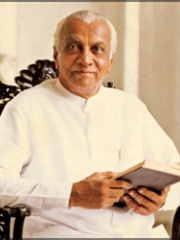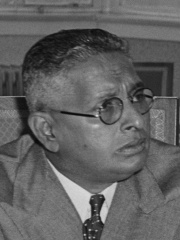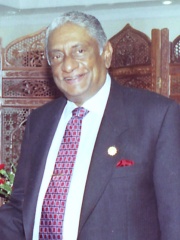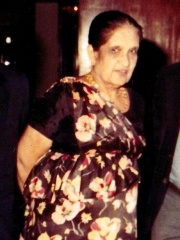
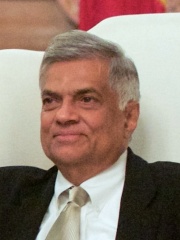
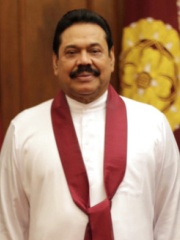
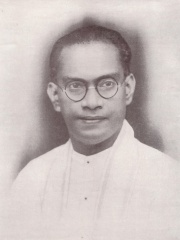
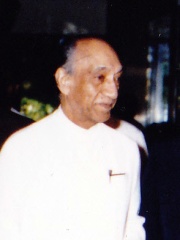
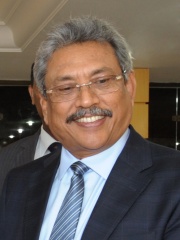
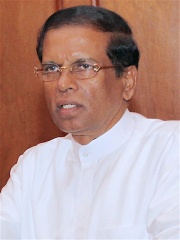
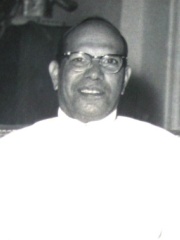
The Most Famous
POLITICIANS from Sri Lanka
This page contains a list of the greatest Sri Lankan Politicians. The pantheon dataset contains 19,576 Politicians, 16 of which were born in Sri Lanka. This makes Sri Lanka the birth place of the 110th most number of Politicians behind Taiwan, and Guinea.
Top 10
The following people are considered by Pantheon to be the top 10 most legendary Sri Lankan Politicians of all time. This list of famous Sri Lankan Politicians is sorted by HPI (Historical Popularity Index), a metric that aggregates information on a biography’s online popularity. Visit the rankings page to view the entire list of Sri Lankan Politicians.

1. Sirimavo Bandaranaike (1916 - 2000)
With an HPI of 65.85, Sirimavo Bandaranaike is the most famous Sri Lankan Politician. Her biography has been translated into 72 different languages on wikipedia.
Sirima Ratwatte Dias Bandaranaike (Sinhala: සිරිමා රත්වත්තේ ඩයස් බණ්ඩාරනායක; Tamil: சிறிமா ரத்வத்தே டயஸ் பண்டாரநாயக்கே; 17 April 1916 – 10 October 2000), commonly known as Sirimavo Bandaranaike (මැතිණිය), was a Sri Lankan politician. She was the world's first female prime minister when she became Prime Minister of Sri Lanka (then the Dominion of Ceylon) in 1960. She chaired the Sri Lanka Freedom Party (SLFP) from 1960 to 1994 and served three terms as prime minister, two times as the chief executive, from 1960 to 1965 and from 1970 to 1977, and once again in a presidential system from 1994 to 2000, governing under the presidency of her daughter Chandrika Kumaratunga. Born into a Sinhalese Kandyan aristocratic family, Bandaranaike was educated in Catholic, English-medium schools, but remained a Buddhist and spoke Sinhala as well as English. On graduating from secondary school, she worked for various social programmes before marrying and raising a family. Playing hostess to her husband S. W. R. D. Bandaranaike, who founded the socialist SLFP in 1951 and became prime minister in 1956, she gained his trust as an informal advisor. Her social work focused on improving the lives of women and girls in rural areas of Sri Lanka. Following her husband's assassination in 1959, Bandaranaike was soon persuaded by the party leadership during a brief time in opposition to enter politics herself and succeed her husband as chairwoman; she returned her party to the government and defeated prime minister Dudley Senanayake's UNP in the July 1960 election. She was then unseated by Senanayake in the 1965 election and became Leader of the Opposition, before winning a large majority in 1970 due to a cleverly structured election alliance with rival Marxist parties. Bandaranaike attempted to reform the former Dominion of Ceylon into a socialist republic by nationalising organisations in the banking, education, industry, media and trade sectors. Changing the administrative language from English to Sinhala and routinely campaigning on Sinhalese nationalist and anti-Tamil policies, which was political mainstream, she exacerbated discontent among the native Tamil population, and with the estate Tamils, who had become stateless under the Citizenship Act of 1948. During Bandaranaike's first two terms as prime minister, the country was plagued by high inflation and taxes, a dependence on food imports to feed the populace, high unemployment, and polarisation between the Sinhalese and Tamil populations because of her Sinhalese nationalist policies. Surviving an attempted coup d'état in 1962, as well as a 1971 insurrection of radical youths, in 1972 she oversaw the drafting of a new constitution and the formation of the Sri Lankan republic, separating it from the British Empire and also extending the parliamentary period until 1977. In 1975, Bandaranaike created what would eventually become the Sri Lankan Ministry of Women and Child Affairs, also appointing the first woman to serve in the Sri Lankan Cabinet aside from herself. Bandaranaike's tenure was marked by inadequate economic development at the national level. She played a large role abroad as a negotiator and a leader among the Non-Aligned Nations. Losing against J. R. Jayewardene in a colossal landslide in the 1977 election and as the UNP government greatly reduced democratic rights, Bandaranaike was stripped of her civil rights in 1980 for claimed abuses of power during her tenure and barred from government for seven years, making her ineligible for the 1982 presidential election in the new presidential system. The new government initially improved the domestic economy, but failed to address social issues, and led the country into a protracted civil war against Tamil militants, which escalated in brutality over the years, especially when the Indian Peace Keeping Force was allowed to intervene. When she was allowed to return as a public figure in 1986, Bandaranaike opposed the Indian intervention, believing it violated Sri Lankan sovereignty. Failing to win the office of President against new UNP leader Ranasinghe Premadasa in 1988, she restored her party, which had by now developed more centrist policies and advocated for a reconciliatory approach towards Tamils in the civil war, as a relevant force in the first parliamentary election after 12 years and served a second time as Leader of the Opposition from 1989 to 1994. When her daughter, who succeeded her as party leader, won the 1994 presidential election, Bandaranaike was appointed to her third term as prime minister and served until her retirement in 2000, two months prior to her death.

2. Ranil Wickremesinghe (b. 1949)
With an HPI of 58.39, Ranil Wickremesinghe is the 2nd most famous Sri Lankan Politician. His biography has been translated into 52 different languages.
Ranil Wickremesinghe (born March 24, 1949) is a Sri Lankan politician who is the 9th and current President of Sri Lanka. He also holds several ministerial positions, including the Minister of Finance, Minister of Defence, Minister of Technology and Minister of Women, Child Affairs and Social Empowerment. Wickremesinghe has led the United National Party since 1994. He has served as Prime Minister of Sri Lanka on five separate occasions, leading six governments, from 1993 to 1994, 2001 to 2004, 2015 to 2018, 2018 to 2019, and for a few months in 2022. He has also served as Leader of the Opposition from 1994 to 2001 and from 2004 to 2015.Born to a wealthy political family, he graduated from University of Ceylon and qualified as an advocate from the Ceylon Law College in 1972. Entering active politics in the mid-1970s with the UNP, he was first elected to Parliament from the Biyagama electorate in the 1977 parliamentary elections and was appointed Deputy Minister of Foreign Affairs, by his uncle and President J. R. Jayewardene. He was thereafter appointed as the Minister of Youth Affairs and Employment, becoming the youngest cabinet minister in Sri Lanka. In 1989, President Ranasinghe Premadasa, appointed Wickremesinghe as the Minister of Industry, Science and Technology and Leader of the House. He succeeded D. B. Wijetunga as prime minister in 1993 following the assassination of Premadasa and Wijetunga's succession to the presidency. He was appointed Leader of the Opposition in November 1994 following the assassination of Gamini Dissanayake during the campaign for the 1994 presidential election. Wickremesinghe was the UNP nominee in the 1999 and 2005 presidential elections, but was defeated by Chandrika Kumaratunga and Mahinda Rajapaksa, respectively. On 9 January 2015, Wickremesinghe was appointed as prime minister by President Maithripala Sirisena, who had defeated President Mahinda Rajapaksa in the 2015 presidential election. His coalition alliance, the United National Front for Good Governance, won the 2015 parliamentary election with 106 seats. Although it fell short of an outright majority, Wickremesinghe was re-elected as prime minister, with over 35 Sri Lanka Freedom Party members joining his cabinet. Wickremesinghe was removed as prime minister on 26 October 2018 by President Maithripala Sirisena with the appointment of former President Mahinda Rajapaksa as prime minister, which Wickremesinghe refused to accept, resulting in a constitutional crisis. The crisis ended with Sirisena re-appointing Wickremesinghe as prime minister on 16 December 2018. He resigned as prime minister on 20 November 2019, and was again succeeded by Mahinda following the 2019 presidential election. He contested the 2020 parliamentary election but failed to secure a seat in Parliament.He re-entered Parliament as a National List MP of the United National Party, and was sworn in as a member of parliament on 23 June 2021. In May 2022, Wickremesinghe was re-appointed as prime minister by President Gotabaya Rajapaksa. On 9 July 2022, Wickremesinghe announced that he was willing to resign amidst mass anti-government protests that saw his personal residence set ablaze, along with the residence of then-President Gotabaya Rajapaska taken over by protestors. He agreed to resign as prime minister once a new government is formed.Wickremesinghe became the acting president on 14 July 2022, after his predecessor Gotabaya Rajapaksa fled the country. Rajapaksa resigned on 14 July 2022, and the same day, Wickremesinghe was sworn in as acting president of Sri Lanka. The same day, he decided to formally abolish the presidential standard and remove the style "His Excellency" when addressing the president. On 20 July 2022, Wickremesinghe was elected as the 9th President via an election by parliament. On 21 July 2022, he took the presidential oath in parliament as president of Sri Lanka.

3. Mahinda Rajapaksa (b. 1945)
With an HPI of 55.88, Mahinda Rajapaksa is the 3rd most famous Sri Lankan Politician. His biography has been translated into 63 different languages.
Mahinda Rajapaksa (Sinhala: මහින්ද රාජපක්ෂ; Tamil: மஹிந்த ராஜபக்ஷ; born Percy Mahendra Rajapaksa; 18 November 1945) is a Sri Lankan politician. He served as the President of Sri Lanka from 2005 to 2015; the Prime Minister of Sri Lanka from 2004 to 2005, 2018, and 2019 to 2022; the Leader of the Opposition from 2002 to 2004 and 2018 to 2019, and the Minister of Finance from 2005 to 2015 and 2019 to 2021. He has been a Member of Parliament (MP) for Kurunegala since 2015.Rajapaksa is a lawyer by profession and was first elected to the Parliament of Sri Lanka in 1970. He served as the leader of the Sri Lanka Freedom Party from 2005 to 2015. Rajapaksa was sworn in for his first six-year term as president on 19 November 2005. He was subsequently re-elected in 2010 for a second term. Rajapaksa was defeated in his bid for a third term in the 2015 presidential election by Maithripala Sirisena, and he left office on 9 January 2015. Later that year, Rajapaksa unsuccessfully sought to become prime minister in the 2015 parliamentary election; that year, the United People's Freedom Alliance was defeated but was elected as the Member of Parliament for the Kurunegala District.On 26 October 2018, Rajapaksa was appointed to the office of prime minister by President Maithripala Sirisena after the United People's Freedom Alliance withdrew from the unity government. The incumbent, Ranil Wickremesinghe, refused to accept his dismissal, stating that it was unconstitutional. This disagreement resulted in a constitutional crisis. The Sri Lankan Parliament passed two no-confidence motions brought against Rajapaksa on 14 and 16 November 2018. Failing to follow proper procedures, President Sirisena rejected both. On 3 December 2018, a court suspended Rajapaksa's powers as prime minister, ruling that his cabinet could not function until establishing its legitimacy. Rajapaksa resigned from the post of prime minister on 15 December 2018. Wickremesinghe was re-appointed as prime minister, and Rajapaksa was appointed Leader of the Opposition.Rajapaksa became the leader of the Sri Lanka Podujana Peramuna in 2019, splitting the Sri Lanka Freedom Party. He became prime minister again on 21 November 2019 after being appointed by his brother, Gotabaya Rajapaksa, who had become president on 18 November after winning the 2019 Sri Lankan presidential election. On 9 August 2020, Rajapaksa was sworn in as Prime Minister of Sri Lanka for the fourth time at a Buddhist temple on Colombo's outskirts. On 3 May 2022, a motion of no confidence aimed at Rajapaksa and his cabinet was declared by opposition leaders. He was targeted during the 2022 Sri Lankan protests over the corruption and mismanagement by the Rajapaksa family which led to an economic crisis that brought Sri Lanka to the point of bankruptcy as it defaulted on its loans for the first time in its history since independence. Protesters called him "Myna" and demanded his resignation which he resisted. On 9 May 2022, Mahinda Rajapaksa organised his supporters at his official residence who were brought by buses and led by SLPP MPs. The loyalists then attacked protestors at Temple Trees before assaulting protestors at Galle Face as attacks were carried out simultaneously against protests in other areas; however this intensified protests and retaliatory violence against Rajapaksa loyalists erupted islandwide and Mahinda Rajapaksa submitted his letter of resignation the same day.During Rajapaksa's political career, he has been accused of multiple crimes including war crimes during the last years of the Sri Lankan civil war as well as other criminal accusations including human rights violations during his presidency, corruption and for instigating violence on anti-government protestors on 9 May 2022. As of 2023 he has been sanctioned by Canada for human rights violations.

4. S. W. R. D. Bandaranaike (1899 - 1959)
With an HPI of 55.84, S. W. R. D. Bandaranaike is the 4th most famous Sri Lankan Politician. His biography has been translated into 35 different languages.
Solomon West Ridgeway Dias Bandaranaike (8 January 1899 – 26 September 1959), also known as "The Silver Bell of Asia" (ආසියාවේ රිදී සීනුව), was a Ceylonese statesman who served as the fourth Prime Minister of the Dominion of Ceylon (now Sri Lanka), serving from 1956 until his assassination. The founder of the left-wing and Sinhalese nationalist Sri Lanka Freedom Party, his tenure saw the country's first left-wing reforms. Born to a wealthy, political family, he studied philosophy, politics, and economics at Christ Church, Oxford, and was called to the bar at the Inner Temple. Returning to Ceylon, he entered local politics by joining the Ceylon National Congress. Having been elected to the Colombo Municipal Council in 1926, he was elected from his family seat in Veyangoda to the State Council of Ceylon for two terms between 1931 and 1947, while serving in the second term as Minister of Local Administration in the Board of Ministers. Having founded the Sinhala Maha Sabha in 1936 on Sinhalese nationalist lines advocating for self-rule in Ceylon, he joined D. S. Senanayake by dissolving the Sinhala Maha Sabha and merging it with the United National Party at its formation in 1947. He was elected to the House of Representatives in 1947 representing the United National Party from Attanagalla, which would become the political seat of his family for the next fifty years. Since the Sinhala Maha Sabha formed the largest segment of the United National Party, D. S. Senanayake appointed Bandaranaike as Minister of Health and Local Government and he was elected as the Leader of the House. Following several disagreements, Bandaranaike resigned from the government and crossed the floor to the opposition, forming the Sri Lanka Freedom Party in 1951. Following D. S. Senanayake's sudden death and the elections that followed, Bandaranaike was elected leader of the opposition. Mustering a powerful coalition called the Mahajana Eksath Peramuna and contesting on the lines of Sinhalese nationalism and socialism, he was able to achieve a landslide victory over the United National Party in the general elections in 1956 thereby becoming the fourth Prime Minister of Ceylon. His tenure saw some of the first left wing reforms instituted by the Freedom Party in Sri Lanka such as the nationalizing bus services and introducing legislation to prohibit caste based discrimination. Bandaranaike removed British naval and air bases in Ceylon and established diplomatic missions with a number of communist states. He implemented a new language policy, the Sinhala Only Act, making Sinhala the sole official language of the country, creating much controversy. On 25 September 1959, Bandaranaike was shot at his town house in Colombo and died of his wounds the day after. A Buddhist monk named Ven Talduwe Somarama was arrested, convicted and hanged for the murder of Bandaranaike. Minister of Education and the acting leader of the house, Wijeyananda Dahanayake was appointed caretaker prime minister by the Governor General and was confirmed by Parliament. Bandaranaike's death led to political turmoil with the Mahajana Eksath Peramuna falling apart under Dahanayake who eventually formed his own party to contest the general elections in March 1960. Although the Freedom Party failed to form a government under the leadership of C. P. de Silva, fresh elections were held four months later after the United National Party government lost the throne speech. Bandaranaike's widow Sirima Ratwatte Dias Bandaranaike lead the Freedom Party to gain a majority in parliament and was appointed the first female prime minister in the world. She expanded on her husband's left-wing reforms in her two terms as prime minister from 1960 to 1964 and from 1970 to 1977. In 1994, Bandaranaike's daughter Chandrika Kumaratunga headed a coalition led by the Freedom Party to be elected prime minister and thereafter president serving from 1994 to 2005, during which Bandaranaike's widow served as prime minister from 1994 to 2000 and Bandaranaike's son Anura Bandaranaike served as Speaker of the Parliament of Sri Lanka from 2000 to 2001.
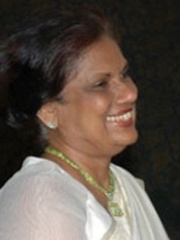
5. Chandrika Kumaratunga (b. 1945)
With an HPI of 55.77, Chandrika Kumaratunga is the 5th most famous Sri Lankan Politician. Her biography has been translated into 57 different languages.
Chandrika Bandaranaike Kumaratunga (Sinhala: චන්ද්රිකා බණ්ඩාරනායක කුමාරතුංග; Tamil: சந்திரிகா பண்டாரநாயக்க குமாரதுங்க; born 29 June 1945), commonly referred to by her initials CBK, is a Sri Lankan politician who served as the fourth executive president of Sri Lanka, from 12 November 1994 to 19 November 2005. She previously served as the prime minister from August to November 1994 and the chief minister of the Western Province from 1993 to 1994. She is the country's first and only female president to date and the country's second female prime minister. She was the leader of the Sri Lanka Freedom Party (SLFP) until the end of 2005.She was elected as president in 1994, when she defeated the UNP candidate Srima Dissanayake in largest landslide victory in Sri Lankan history, winning 62% of the total votes cast.

6. J. R. Jayewardene (1906 - 1996)
With an HPI of 54.44, J. R. Jayewardene is the 6th most famous Sri Lankan Politician. His biography has been translated into 35 different languages.
Junius Richard Jayewardene (Sinhala: ජුනියස් රිචඩ් ජයවර්ධන; Tamil: ஜூனியஸ் ரிச்சட் ஜயவர்தனா; 17 September 1906 – 1 November 1996), commonly abbreviated in Sri Lanka as J.R., was a Sri Lankan lawyer, Public official and a stateman who served as Prime Minister of Sri Lanka from 1977 to 1978 and as the second President of Sri Lanka from 1978 to 1989. He was a leader of the nationalist movement in Ceylon (now Sri Lanka) who served in a variety of cabinet positions in the decades following independence. A longtime member of the United National Party, he led it to a landslide victory in 1977 and served as prime minister for half a year before becoming the country's first executive president under an amended constitution.A controversial figure in the history of Sri Lanka, while the open economic system he introduced in 1978 brought the country out of the economic turmoil Sri Lanka was facing as the result of the preceding closed economic policies, Jayawardene's actions, including his response to the Black July riots of 1983, have been accused of contributing to the beginnings of the Sri Lankan Civil War.

7. Gotabaya Rajapaksa (b. 1949)
With an HPI of 54.02, Gotabaya Rajapaksa is the 7th most famous Sri Lankan Politician. His biography has been translated into 47 different languages.
Nandasena Gotabaya Rajapaksa, (Sinhala: නන්දසේන ගෝඨාභය රාජපක්ෂ; Tamil: நந்தசேன கோட்டாபய ராஜபக்ஷ; born 20 June 1949) is a former Sri Lankan politician and military officer, who served as the eighth President of Sri Lanka from 18 November 2019 until his resignation on 14 July 2022 due to months of public anger. He previously served as Secretary to the Ministry of Defence and Urban Development from 2005 to 2015 under the administration of his elder brother former President Mahinda Rajapaksa, during the final phase of the Sri Lankan Civil War. Born to a political family from the Southern Province, Rajapaksa was educated at Ananda College, Colombo and joined the Ceylon Army in April 1971. Following basic training at the Army Training Centre, Diyatalawa, he was commissioned as signals officer and later transferred to several infantry regiments. He saw active service in the early stages of the Sri Lankan Civil War with the elite Gajaba Regiment, taking part in several major offensives such as the Vadamarachi Operation, Operation Strike Hard and Operation Thrividha Balaya, as well as counter-insurgency operations during the 1987–1989 JVP insurrection. Rajapaksa took early retirement from the army and moved into the field of information technology, before immigrating to the United States in 1998. He returned to Sri Lanka in 2005, to assist his brother in his presidential campaign and was appointed Defence Secretary in his brother's administration. During his tenure the Sri Lankan Armed Forces successfully concluded the Sri Lankan Civil War defeating the LTTE and killing its leader, Velupillai Prabhakaran in 2009. He was a target of an assassination attempt in December 2006 by a Tamil Tiger suicide bomber. Following the war, Rajapaksa initiated many urban development projects. He stepped down following the defeat of his brother in the 2015 presidential election. Rajapaksa emerged as the SLPP candidate for the 2019 presidential election, in which he successfully contested on a pro-nationalistic, economic development and national security platform. He was the first president of Sri Lanka with military background and also the first elected president who had never held an elected office before. During his presidency, Rajapaksa increased his presidential powers through the 20th Amendment and nepotism rose as members of the Rajapaksa family were appointed to several positions of power, and led the country during the onset of the COVID-19 pandemic. Economic mismanagement drove the country to bankruptcy, causing Sri Lanka to declare default for the first time since gaining independence in 1948. This economic crisis caused shortages and inflation, leading to the 2022 Sri Lankan protests and political crisis. The Rajapaksa administration responded by declaring a state of emergency, which allowed the military to arrest civilians, imposing curfews, restricting social media, assaulting protesters and journalists, and arresting online activists. Rajapaksa refused to step down, even after protests became violent, until 14 July, when Rajapaksa fled the country via a military aircraft and began a 50-day self-exile, and officially emailed his resignation letter from Singapore the next day. On 2 September, Rajapaksa returned to Sri Lanka.

8. Maithripala Sirisena (b. 1951)
With an HPI of 50.67, Maithripala Sirisena is the 8th most famous Sri Lankan Politician. His biography has been translated into 54 different languages.
Maithripala Yapa Sirisena (Sinhala: පල්ලෙවත්ත ගමරාළලාගේ මෛත්රීපාල යාපා සිරිසේන; Tamil: பல்லேவத்த கமராளலாகே மைத்திரிபால யாப்பா சிறிசேன; born 3 September 1951) is a Sri Lankan politician who served as the seventh President of Sri Lanka from 9 January 2015 to 18 November 2019. Sirisena is Sri Lanka's first president from the North Central Province of the country and does not belong to the traditional Sri Lankan political elite. He is currently a member of parliament from Polonnaruwa. Sirisena joined mainstream politics in 1989 as a member of the Parliament of Sri Lanka and has held several ministries since 1994. He was the general-secretary of the Sri Lanka Freedom Party and was Minister of Health until November 2014 when he announced his candidacy for the 2015 presidential election as the opposition coalition's "common candidate". His victory in the election is generally viewed as a surprise, coming to office through the votes won from the alternative Sinhala-majority rural constituency and the Tamil and Muslim minority groups that have been alienated by the Rajapaksa government on post-war reconciliation and growing sectarian violence. Maithripala Sirisena pledged to implement a 100-day reform program where he promised to rebalance the executive branch within 100 days of being elected, by reinforcing Sri Lanka's judiciary and parliament, to fight corruption and to investigate allegations of war crimes from 2009, repeal the controversial eighteenth amendment, re-instate the seventeenth amendment and appoint UNP leader Ranil Wickremesinghe as Prime Minister. He later was reported to have publicly disavowed this program, claiming that he did not know where it originated.Sirisena was sworn in as the sixth Executive President before Supreme Court judge K. Sripavan in Independence Square, Colombo at 6:20 p.m. on 9 January 2015. Immediately afterwards he appointed Ranil Wickremesinghe as the new Prime Minister. After being sworn in Sirisena stated that he would only serve one term. Sirisena voluntarily transferred significant presidential powers to parliament on 28 April.In 2018, Sirisena appointed the former president Mahinda Rajapaksa (his former rival) as the Prime Minister, wrote a letter firing Prime Minister Ranil Wickremesinghe (with whose major support he became the president in 2015) and prorogued Parliament, all in apparent contradiction to the Constitution of Sri Lanka, instigating a constitutional crisis. This marks Sirisena's second, and most successful attempt to bring Rajapaksa to power.

9. William Gopallawa (1896 - 1981)
With an HPI of 50.14, William Gopallawa is the 9th most famous Sri Lankan Politician. His biography has been translated into 25 different languages.
William Gopallawa (Sinhala: විලියම් ගොපල්ලව, Tamil: வில்லியம் கோப்பல்லாவ; 17 September 1896 – 31 January 1981) was the last Governor-General of Ceylon from 1962 to 1972 and the first and only non-executive President of Sri Lanka from 1972 to 1978, when Ceylon declared itself a republic and changed its name to Sri Lanka. Gopallawa served as Governor-General during the tenure of three different governments, two headed by Sirimavo Bandaranaike of the SLFP and one headed by Dudley Senanayake of the UNP.
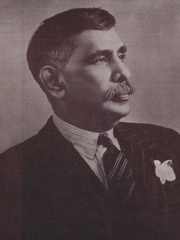
10. D. S. Senanayake (1883 - 1952)
With an HPI of 49.50, D. S. Senanayake is the 10th most famous Sri Lankan Politician. His biography has been translated into 23 different languages.
Don Stephen Senanayake (Sinhala: දොන් ස්ටෙෆන් සේනානායක; Tamil: டி. எஸ். சேனநாயக்கா; 20 October 1884 – 22 March 1952) was a Ceylonese statesman. He was the first Prime Minister of Ceylon having emerged as the leader of the Sri Lankan independence movement that led to the establishment of self-rule in Ceylon. He is considered as the "Father of the Nation".Born to an entrepreneur from the village of Botale, Senanayake was educated at S. Thomas' College, Mutwal before briefly working as a clerk in the Surveyor General's Department. Joining the family business, he managed the family own estates and the Kahatagaha Graphite Mine. Long with his brothers, Senanayake became active in the temperance movement which grew into the independence movement following 1915 Sinhalese-Muslim riots, in which the Senanayake brothers were imprisoned without charges for 46 days. He was elected unopposed in 1924 to the Legislative Council of Ceylon from Negombo, becoming the Secretary of the unofficial members group of the Legislative Council. In 1931, he was elected to the State Council of Ceylon, where he served as Minister of Agriculture and Lands. He was elected to the first Parliament of Ceylon forming a government and serving as Ceylon's first Prime Minister from 1947 until his death in 1952.
People
Pantheon has 19 people classified as Sri Lankan politicians born between 1883 and 1965. Of these 19, 7 (36.84%) of them are still alive today. The most famous living Sri Lankan politicians include Ranil Wickremesinghe, Mahinda Rajapaksa, and Chandrika Kumaratunga. The most famous deceased Sri Lankan politicians include Sirimavo Bandaranaike, S. W. R. D. Bandaranaike, and J. R. Jayewardene. As of April 2024, 3 new Sri Lankan politicians have been added to Pantheon including Dinesh Gunawardena, John Kotelawala, and Lakshman Kadirgamar.
Living Sri Lankan Politicians
Go to all RankingsRanil Wickremesinghe
1949 - Present
HPI: 58.39
Mahinda Rajapaksa
1945 - Present
HPI: 55.88
Chandrika Kumaratunga
1945 - Present
HPI: 55.77
Gotabaya Rajapaksa
1949 - Present
HPI: 54.02
Maithripala Sirisena
1951 - Present
HPI: 50.67
Dinesh Gunawardena
1949 - Present
HPI: 47.60
Alexander Khloponin
1965 - Present
HPI: 36.73
Deceased Sri Lankan Politicians
Go to all RankingsSirimavo Bandaranaike
1916 - 2000
HPI: 65.85
S. W. R. D. Bandaranaike
1899 - 1959
HPI: 55.84
J. R. Jayewardene
1906 - 1996
HPI: 54.44
William Gopallawa
1896 - 1981
HPI: 50.14
D. S. Senanayake
1883 - 1952
HPI: 49.50
Ranasinghe Premadasa
1924 - 1993
HPI: 48.88
Ratnasiri Wickremanayake
1933 - 2016
HPI: 46.71
Dudley Senanayake
1911 - 1973
HPI: 46.45
D. M. Jayaratne
1931 - 2019
HPI: 45.67
Dingiri Banda Wijetunga
1916 - 2008
HPI: 45.61
John Kotelawala
1897 - 1980
HPI: 43.44
Lakshman Kadirgamar
1932 - 2005
HPI: 38.83
Newly Added Sri Lankan Politicians (2024)
Go to all RankingsDinesh Gunawardena
1949 - Present
HPI: 47.60
John Kotelawala
1897 - 1980
HPI: 43.44
Lakshman Kadirgamar
1932 - 2005
HPI: 38.83
Overlapping Lives
Which Politicians were alive at the same time? This visualization shows the lifespans of the 12 most globally memorable Politicians since 1700.

